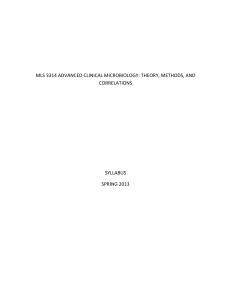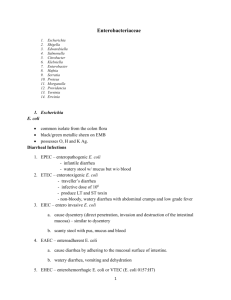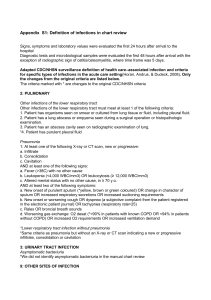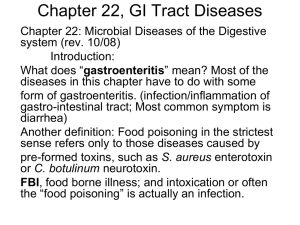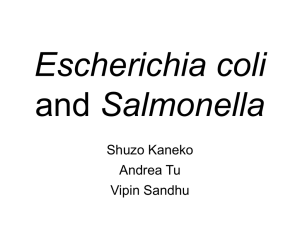MECHANISMS OF HUMAN DISEASE
advertisement
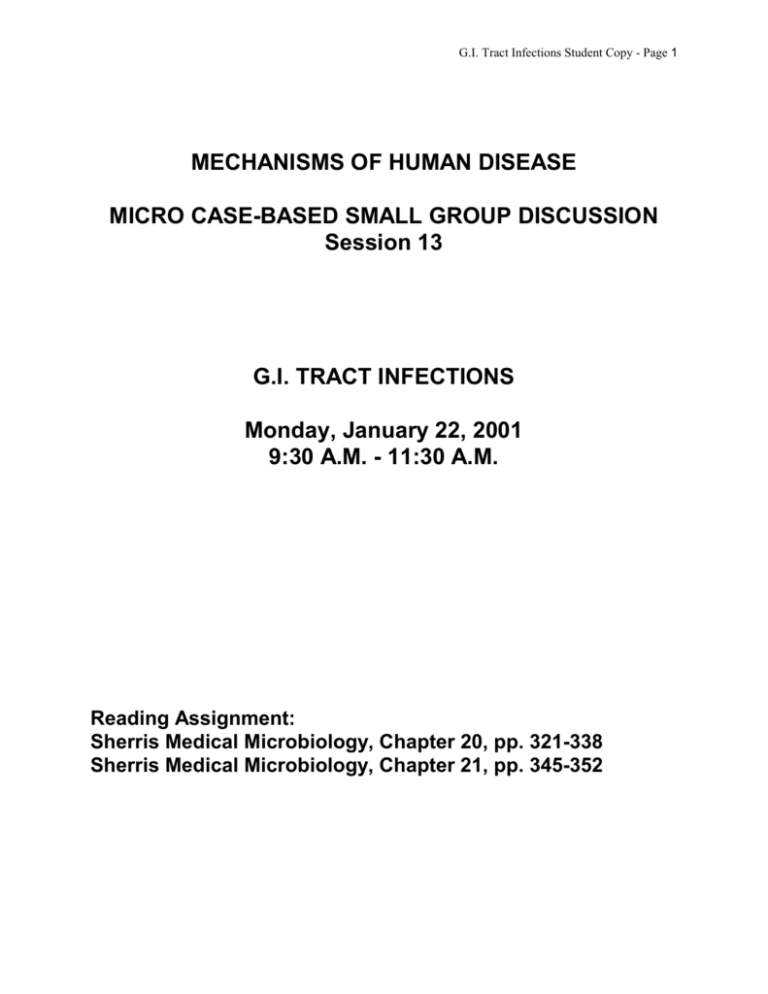
G.I. Tract Infections Student Copy - Page 1 MECHANISMS OF HUMAN DISEASE MICRO CASE-BASED SMALL GROUP DISCUSSION Session 13 G.I. TRACT INFECTIONS Monday, January 22, 2001 9:30 A.M. - 11:30 A.M. Reading Assignment: Sherris Medical Microbiology, Chapter 20, pp. 321-338 Sherris Medical Microbiology, Chapter 21, pp. 345-352 G.I. Tract Infections Student Copy - Page 2 CASE HISTORY 1 A 26 year old woman comes to the traveler's clinic complaining of profound weakness and severe diarrhea of one and one-half days' duration. She has just returned from Africa where she worked for two months in a refugee camp on the border of Rwanda and Zaire. On the plane she developed abdominal bloating, intestinal gurgling and nausea followed by two loose bowel movements. Soon she was having profuse watery diarrhea occurring hourly. Stools were clear and without odor. You meet her in the clinic. She looks very weak but has no fever. Blood pressure is 94/60 lying down and drops to 72/40 standing. She is admitted to the hospital. Admitting laboratory studies include the following: . Sodium Potassium Chloride CO2 Fecal leukocytes Fecal occult blood 138 meq/L 2.1 meq/L 95 meq/L 15 meq/L None seen Negative 1. What is the mechanism of transmission of Vibrio cholerae? 2. What host factors increase the likelihood of infection with V. cholerae? 3. Describe the mechanism of action of cholera toxin. 4. Besides toxin production, what other virulence determinant is essential for the development of cholera? G.I. Tract Infections Student Copy - Page 3 5. How would you manage the dehydration? Why can oral rehydration fluid be used in many cases of cholera? 6. What advice would you provide to other travelers to Rwanda concerning avoidance of cholera? 7. List three public health solutions to the global problem of epidemic cholera. G.I. Tract Infections Student Copy - Page 4 G.I. Tract Infections Student Copy - Page 5 Case History 2 An 8 year old boy was admitted to the Pediatric Service with edema and high blood pressure. He had been well until 8 days prior to admission when he developed severe abdominal pain, nausea, vomiting and diarrhea. On the second day the diarrhea became bloody. The diarrhea continued but had lessened in amount, remaining bloody. The mother did not report any fever. On examination he appeared pale and had mild facial edema. Temperature was 37.6'C pulse 104 and regular and the blood pressure was 140/95. His abdomen was tender. Chest x-ray was clear. Abdominal x-ray disclosed edema of the transverse and descending colon with thumbprinting. Laboratory studies included the following. Hemoglobin Peripheral smear WBC Platelet count Creatinine Lactic dehydrogenase Fecal leukocytes Stool culture 8.5 gm/dl Schistocytes present 17.5x103/mm3 42,000/mm3 5.4 mg/dl 485 IU/ml Absent Sorbitol-negative Escherichia coli 1. What enteropathogenic type of Escherichia coli is causing this infection? 2. What complication of E. coli enteritis did this patient develop? Define the complication. 3. List the virulence characteristics of E. coli that are responsible for this syndrome? G.I. Tract Infections Student Copy - Page 6 4. Describe the pathogenic process. In your response address how the infectious microorganism might be responsible for hemorrhage, anemia, and renal failure. 5. How is the infection acquired? Include in your answer an explanation of how the most common vehicle of transmission is likely to cause large outbreaks. 6. What are the other mechanisms by which E. coli is able to cause diarrhea? G.I. Tract Infections Student Copy - Page 7 7. Should the child be isolated in the hospital? 8. How does one diagnose the infection? 9. Should antibiotics be used to treat the child? If so, which ones are used? G.I. Tract Infections Student Copy - Page 8 Case History 3 A 59 year old man presents with a one day history of fever, abdominal cramps and diarrhea. His symptoms began six hours after the onset of the "runs" in two of his grandchildren and their mother all of whom had been visiting from their dairy and poultry farm in Wisconsin. The day before becoming ill all had eaten a meal consisting of Caesar salad, pasta with stir fried vegetables, bread and apples. Other than the abdominal pain and six unformed bowel movements which contained mucus, he had no complaints. On examination the man appeared ill. Temperature was 39.3 C, pulse 100 and blood pressure 110/80 standing. He had no rash. The abdomen was tender in the periumbilical area. WBC Fecal leukocytes Fecal occult blood 9.8 X 103 /mm3 Positive Negative Stool culture is growing motile, lactose non-fermenting, gram rod that is H2S. Positive. 1. What is the likely cause of this man's diarrhea' 2. Do these organisms cause diarrhea by invasion or toxin production? Describe what is known of the pathogenesis of diarrhea caused by these organisms? 3. How did the members of the family become infected? What is the usual route of infection with this pathogen? 4. What is the preferred therapy of enteritis due to salmonella? G.I. Tract Infections Student Copy - Page 9 5. What other clinical syndromes are described with salmonella infection? 6. Given the present distribution systems for meat, poultry and dairy products in the United States, what measures could be adopted to reduce the spread of salmonella infection? G.I. Tract Infections Student Copy - Page 10 Case History 4 A 49- year- old woman presented to the emergency room complaining that she had vomited up blood at home. She had been suffering with sharp epigastric pain, especially in the morning, for one week before the vomiting began. The pain was accompanied by mild nausea and was relieved by food or antacids. She had a long history of peptic ulcer disease and was initially diagnosed with duodenal ulcer at age16. Despite at least six discrete episodes of ulcer documented by x-ray or endoscopy, she had never undergone surgery. Workup for Zollinger-Ellison syndrome (a gastrin producing pancreatic adenoma) was negative. A nasogastric tube was placed revealing blood in the stomach which cleared after gastric lavage with iced saline. Immediate endoscopy revealed scarring of the pylorus with a 2 cm ulcer in the first portion of the duodenum. Biopsy of the ulcer revealed curved bacilli with Warthin-Starry silver staining and a positive urease test. 1. Describe the morphologic and microbiologic features of Helicobacter pylori? 2. What is the frequency of infection with H. pylori in the United States? How does the distribution of H. pylori infection differ in populations from underdeveloped countries? 3. What phenotypic characteristics of H. pylori are thought to account for its virulence? Which of them appear to be most important? The nasogastric tube aspirate remained blood free and the tube was removed. She was started on an H2 blocker and the pain rapidly subsided. 4. What further treatment might be helpful? What long term benefits could she expect if she were to receive the additional treatment? *****
